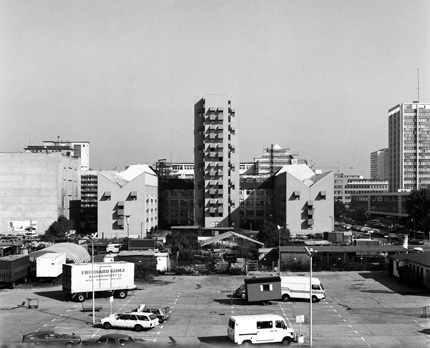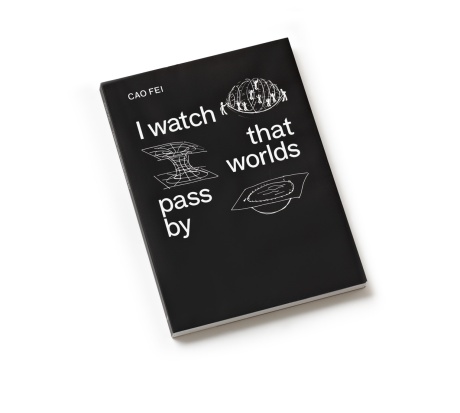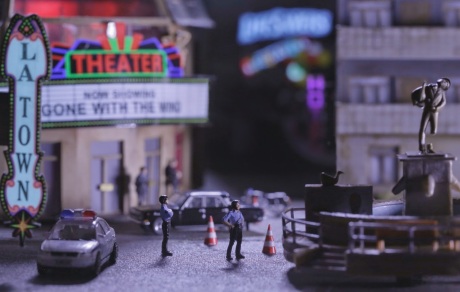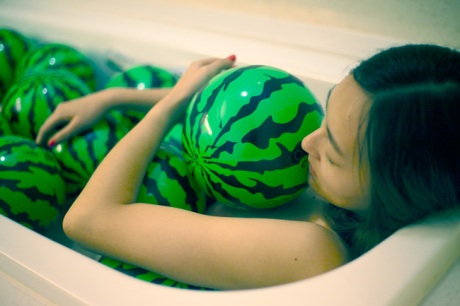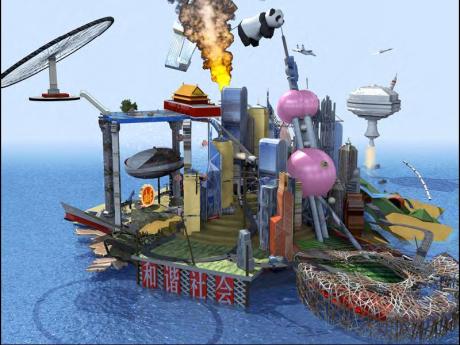This is from the October 2015 special issue of e-flux journal. It was commissioned by one of the editors, Nikolaus Hirsch, after he visited the apartment I’ve been calling home for a couple of years: a tower in Berlin conceived by John Hejduk. By now, I receive visitors with a set tour that slips and slides according to the weather and the limits of my memory. The below is an attempt to crystallize as many of the facts and fictions I’ve gathered while living in this special place. A guide to everyone that will never come to see me here, floating in space.
1. Turn onto Besselstraße. You’ll see the Tower, grey and green. Look for the left-hand entrance. Pass the kids’ playground. Press buzzer name _______. I’ll let you in. Take the elevator to the tenth floor.
2. Look out for the single piece of graffiti in the elevator (always the word “SEX,” in capitals).
3. Just so you know, there is no other apartment on that floor. Just this one. The elevator doors will open and you’ll see me waiting for you.
4. After I’ve greeted you with a Continental kiss on both cheeks (one kiss feels inadequate; three, inconvenient), I’ll invite you inside my temporary home. And ask you to take your shoes off. It’s an Asian tradition I take with me wherever I go.
5. Even angels have to abide.
6. “The elevator brought you up one of the five towers,” I’ll explain, “and now, we’re standing in the central tower.” You’ll look around the square white room, roughly six by six meters. Plain black carpet. Mostly unadorned.

John Hejduk, Berlin Tower: Elevations and Plans, 1985-1986. Reprographic copy on paper. John Hejduk fonds, collection Canadian Center for Architecture, Montréal
7. “Hejduk was the architect.” You will look puzzled. It’s obvious you had an expensive education. You’re an avant-garde literature savant. A fan of untitled atonal dirges. You own every seminal Semiotext(e) paperback.
8. But you’ve never heard of John Hejduk.
9. I’ll launch, quite abruptly, into a customized Wikipedia biography. He was born in 1929 and died in 2000. Between these mortal parentheses, Hejduk was one of the “New York Five,” a loose band of neo-modern architects who rose to prominence in the late 1960s and early ’70s, famous for reintroducing formalism to discourse and building a number of rich people’s houses in rich parts of America. Soon after, Hejduk went his own inimitable way, which, it seems, was always his preferred way.
10. Hejduk the poet.
11. Hejduk the mystic.
12. Hejduk the dramaturge.
13. Hejduk the dean of the Cooper Union, New York, for decades. An influential teacher.
14. I’ll point at some black-and-white printouts pinned on my white walls. Scratchy ink drawings showing menageries of objects. Part animal and part industrial factory. Little lives floating between second and third dimensions. I’ll pick up a Hejduk book called Victims,from 1986. I’ll open it to pages that describe a theatrical cast of characters, who they are, what defines their individuality, how they belong to this … community, let’s call it. Or a troupe. The descriptions: quotidian and metaphysical at the same time.

John Hejduk, Berlin Tower: Sectional Details, 1985-1986. Felt-tip pen on wove paper. John Hejduk fonds, collection Centre Canadien d’Architecture, Canadian Center for Architecture, Montréal.
15. I’ll try and remember this quote by Hejduk: “I cannot do a building without building a new repertoire of characters, of stories, of language, and it’s all parallel. It’s not just building per se, it’s building worlds.”
16. Building worlds.
17. You may be surprised that for someone of his stature, Hejduk built relatively few buildings. (Less than a handful.) However, he was prolific in other ways.
18. I’ll gesture for you to follow me. “We’re in one of the walkways between the big tower and one of the smaller towers.” It’s just 70 cm long, and about 50 cm wide. “Notice. Windows on both sides.” You will feel like you’re also floating somewhere between two-dimensional and three-dimensional space. You will feel tiny and also immense because Berlin slices right through this anti-room.
19. You’re part of it and apart from it.
20. This feeling was often considered to be the defining condition of life in the second half of the twentieth century. “I recommend Colin Wilson’s The Outsider.” You think I’m being quaint.
21. (Later on, you may admit the small walkway was erotic.) (I would agree.)
22. The kitchen tour will not take long because it’s just 1.8 m by 1.8 m, fitted out in original grey laminate 1988 cupboards. “1988 was not a high point in kitchen design.” There’s another window, this one with a green metal canopy floating over it. The view turns the outside into a slowly moving still life.

Photo by the author, 2014
23. I’ll walk you to the other side to show you the mirroring room, also in its own tower (the third), separated by another walkway with its two facing windows.
24. You will ask me what Hejduk intended with such impractically small rooms. “Well,” I’ll pontificate, “the whole apartment oscillates between spaces that seem too big and too small.” I’ll say that we only become conscious of space when it is either too big (a cathedral, a palace) or it is too small (a railway cabin, a prison cell). For most of us, lived space happens in the midground and, as such, washes over us quietly. Anonymously.
25. Some trivia: Hejduk was very tall. Imposingly tall.
26. I’ll open the two window-doors in the living room and tell you to go through the one on the left and I will go out of the one on the right.
27. Separated by about 40 cm, we now have one balcony each. A perfect cube approximately one by one by one meter, encased in gunmetal green painted steel. I think of them as two Carl Andre sculptures cantilevering above others like them below and above.
28. Why two, you might ask (scanning these floating square orbs for erotic potential). “It’s so she can sit there in peace and he can sit here in his own peace. They pass things to one another butter, coffee, a hardback copy of Robbe-Grillet’s Jealousy but maintain their sovereignty.”
29. You will either find this a sad model of togetherness …
30. … or something liberating and true.
31. At this point, will another truth bloom in your mind?
32. “Today, luxury living has come to mean expensive finishes, furnishings, bathroom taps, and ‘exclusive views.’ Things to display. This has come at the expense of any kind of original idea on how to live.” For Hejduk, the antithesis is the case. All the material finishes in this building are humane but basic, suitable for social housing. Linoleum. Square white tiles. Cheap grout. “The luxury Hejduk offers is a radical rethinking of the plan of a house or an apartment. Its received principles of sense. He forces you to inhabit through invention.”

Photo by the author, 2014
33. This is a different kind of luxury. One that may have died in the handover from the twentieth to twenty-first centuries.
34. To live in an idea about living is wealth not measured in money.
35. “How did you get this place?” you will ask. Because everyone asks, expecting an answer rich in nepotism or savvy connections. I will honestly reply, “Providence.” You will say, “What?” I clarify, “Craigslist.”
36. “Let’s go upstairs.” This other Hejduk quote is pinned on the wall: “I don’t make any separations. A poem is a poem. A building’s a building. Architecture’s architecture. Music is music. I mean, it’s all structure. It’s structure.”
37. We’ll be on the eleventh floor now. Another large white space, four windows, two like square eyes, and we are the brain, gazing out at the city.
38. If you haven’t heard of Hejduk then you won’t have heard of IBA Berlin (Internationale Bauausstellung). An initiative from 1979 led by the architects Josef Paul Kleihues and Hardt-Walt Hämer to add and renovate much-needed West Berlin housing stock mostly welfare housing and culminating in 1987 on the 750th birthday of Berlin. The date would be exactly thirty years after Interbau, a similar initiative that bequeathed Berlin the Modernist district Hansaviertel, replete with Alvar Aalto, Oscar Niemeyer, and, further away, Le Corbusier for the urban un-rich.
39. Size wasn’t what made IBA Berlin so unique. It was, in particular, Kleihues’s choice of architects. On the one hand, there were historical postmodernists, who, in the early to late 1980s, had usurped orthodox or late modernists as the go-to avant-garde. Aldo Rossi, Charles Moore, Stanley Tigerman. However, Kleihues also enlisted many from an outmoded neo-modern camp. OMA, Zaha Hadid, Peter Eisenman, Raimund Abraham often built their first “real” buildings confined by stringent Berlin building regulations and challenging budgets.
40. IBA Berlin also commissioned three projects from John Hejduk. This poet of the unbuilt who kept a quote by Alain Robbe-Grillet pinned above his drawing desk: “The hallucinatory effect derives from the extraordinary clarity and not from mystery or mist. Nothing is more fantastic ultimately than precision.”
41. Robbe-Grillet was talking about Franz Kafka.
42. “This building would never be commissioned by anyone else,” I’ll explain to you, “because it’s so completely irrational.” A tower with just seven apartments. Two storys each. Twenty windows each. Not for affluent condo-dwellers, but originally intended for the DAAD residency program, yet ultimately never adopted for that purpose. There are also two lower blocks, with twenty apartments each, which initially housed mainly Turkish residents and families. The front facades are childlike faces, possibly crying.
43. In 1988, when the complex was finished, Checkpoint Charlie was just a few minutes away. The Wall sliced across Zimmerstrasse. This whole area between Friedrichstrasse and Charlottenstrasse, was a prominent hinterland edge of West Berlin, close to the Nazi command center. History on the sidewalks.
44. Then the Wall came down a year later.
45. The edge condition of East Berlin fused with the edge condition of West Berlin and instead of cancelling each other out as I’ll argue to you they combined their alienating forces.
46. This area (what is it? Friedrichstadt? Kreuzberg? Mitte?) has the paradoxical quality of being Berlin’s geometrical center while often being unmarked in Berliners’ memories or minds. An ongoing no man’s land, only now on the cusp of sweeping change.
47. “This is the bedroom. It can’t even fit a full double bed.” My artist landlady has hand-built a timber frame that acts as a 1.5 person bed. This room also can’t fit anything else except a single window. “Look,” and I’ll point at Potsdamer Platz over there. “That’s where the sun goes down.” You’ll lie on the bed and all you’ll see is the yellowing light on the grey concrete of the cylindrical tower outside the window. You’ll again feel like you’re between two-dimensional and three-dimensional space. At peace.
48. I’ll then take you to the last part of this tour. We’ll have to go up the spiral stairs, which is inside the cylindrical tower, the fifth and final one. The view up and down the tower is a dirty realist Vertigo. “It’s always cold. It doesn’t want you to be inside it for long.” I’ll whisper to you that “I am convinced these stairs link heaven to hell.”
49. We’ll climb the industrial ladder to the roof.
50. Here, you will see the plan of the building, naked. You’re inside the drawing. The individual square and rectangular and cylindrical shapes connected by short bridges. Instead of carpet or linoleum, here you stand on large, smooth, grey pebbles. “It feels like a private Japanese garden.” You’ll nod.
51. We see the sun vanishing behind the skyline that’s not Berlin or anywhere particular. An ersatz horizon.
52. I’ll tell you to look down.
53. Metallic stars protrude from the walls, silently and regularly arrayed.

Photo by the author, 2013
54. What are they?
55. The most convincing story I’ve heard is: “They’re grips for angels to hold onto when they climb the sides of the tower.”
56. If we were anywhere else, you’d look at me bemused. As if I was overidentifying with supernatural sap. Here, it’s the only rational reason.
57. “Wings of Desire came out in 1987,” I’ll mention. “Wasn’t that a film about angels in Berlin?” you ask.
58. Yes. It was. Marion as played by Solveig Dommartin, who couldn’t see the ponytailed outsider angels, and Damiel played by Bruno Ganz, inhabited their own parallel dimension next to humans. Don’t forget Nick Cave, one of West Berlin’s star residents of the mid-1980s, who utters the words, “I’m not gonna tell you about a girl … I’m not gonna tell you about a girl … I wanna tell you about a girl …”
59. You, who have been so patient with my exhaustive circuit, you will clasp my hand in flickering friendship, and, standing unusually tall, as if with wings, recite the following:
60. “The Angel dropped
and knelt
to ask a pardon
for its announcement
anticipating the coming entombment
The stone vault door
exploded into putrid passage
Italian was softly spoken
The cloth was loomed
in iris
Waxed bannisters
Pinioned the entry
Impregnation was complete
Joseph wept”1
[‘Annunciation’ by John Hejduk, taken from Such Places as Memory: Poems 1953 1996 (Cambridge, MA: MIT Press, 1998)]
